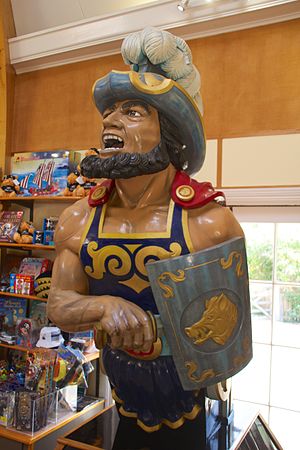HMS Gladiator (1783)

Replica of HMS Gladiator's figurehead at Buckler's Hard
|
|
| History | |
|---|---|
|
|
|
| Name: | HMS Gladiator |
| Builder: | Adams, Bucklers Hard |
| Launched: | 20 January 1783 |
| Fate: | Broken up in August 1817 |
| General characteristics | |
| Class and type: | Roebuck-class ship |
| Type: | 44-gun fifth rate |
| Tons burthen: | 882 tons (exact; bm) |
| Length: |
|
| Beam: | 37 ft 11 1⁄2 in (11.570 m) |
| Draught: |
|
| Depth of hold: | 16 ft 5 in (5.00 m) |
| Propulsion: | Sails |
| Sail plan: | Full-rigged ship |
| Armament: |
|
HMS Gladiator was a 44-gun fifth-rate Roebuck-class ship of the Royal Navy. She was launched on 20 January 1783 by Henry Adams of Bucklers Hard. She spent her entire career on harbour service, never putting to sea. Even so, her crew earned prize money for the seizure of two Russian and five American ships. Her sessile existence made her an excellent venue for courts-martial and a number of notable ones took place aboard her. She was broken up in 1817.
Gladiator was commissioned in December 1792 under Lieutenant Samuel Hayter as a convalescent ship. Then, still under Hayter, she was recommissioned in February 1794 as a guardship. In December 1795 she was under the command of Lieutenant Stephen Parker, followed by Lieutenant Emanuel Hungerford from September 1799. She was Rear-Admiral Sir Richard Bickerton's flagship from February 1800 to May. Lieutenant Joseph Bromwich then took command of Gladiator, being succeeded in September by Lieutenant John Connolly. From December 1801 she was again a convalescent ship and the flagship for Rear-Admiral Sir John Holloway until to April 1802 when she was paid off.
Gladiator was recommissioned in April 1803 under Lieutenant Thomas Harrison. From May she was again Holloway's flagship until June 1804 when she became Rear-Admiral Sir Isaac Coffin's flagship. In February 1807 she came under the command of Lieutenant John Price as a convalescent ship.
On 26 October 1806, Tsar Alexander I of Russia declared war on Great Britain. The official news did not arrive there until 2 December, at which time the British declared an embargo on all Russian vessels in British ports. Gladiator was one of some 70 vessels that shared in the seizure of the 44-gun Russian frigate Speshnoy (Speshnyy), then in Portsmouth harbour. The British seized the Russian storeship Wilhelmina (Vilghemina) at the same time. The Russian vessels were carrying the payroll for Vice-Admiral Dmitry Senyavin’s squadron in the Mediterranean.
...
Wikipedia
